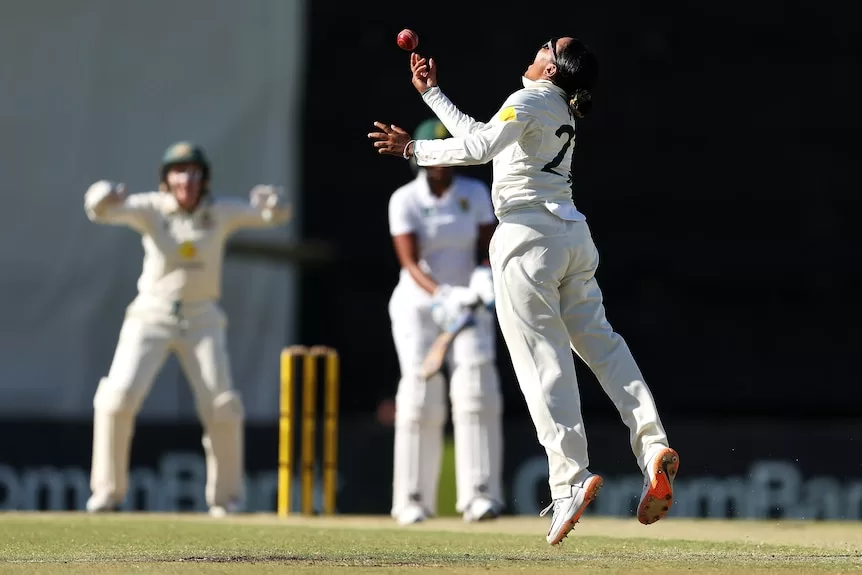- In short: More than 70 per cent of sports news coverage in Victoria was dedicated to men’s sport.
- Twenty-seven per cent of all stories were written by women journalists.
- What’s next? The Office for Women in Sport and Recreation has made recommendations to media and sporting organisations to accelerate change.
Research released this week reported that only 15 per cent of sports news coverage in Victoria in 2022–2023 covered women’s sport.
That means for every story about women’s sport, on average 5.4 stories on men’s sport were created.
The research, commissioned by the Victorian government’s Office for Women in Sport and Recreation (OWSR), found women’s sport was under-represented across media formats (print, online, radio) and geographical locations.
In a week when the gender pay gap at Australia’s biggest companies was revealed publicly for the first time, it can start to feel a little like data overload.
Is this telling us what we already thought was happening?
Do you have a story idea about women in sport?
Email us [email protected]
Data is a line in the sand
OWSR director Sarah Styles says they commissioned the research for several reasons.
While community sport has taken strides towards providing fairer access to facilities and opportunities to play, she believes an unbalanced sports media undermines this progress by perpetuating the stereotype that sport is a male pursuit.
“It’s saying, ‘You know what’s actually important? Men’s sport.’ That’s still the default,” she said.
For elite sportswomen, this lack of representation also has compounding financial impacts on their ability to fully professionalise as a team or league.
“If you’re not getting your stories told, your ability to build your fan base, attract corporate sponsors, and ultimately get broadcast revenue to help you grow [is impacted],” Ms Styles said.
“This is often used against women’s sport, ‘Surely this is just what the market wants.’
“Whereas I would say there’s a whole bunch of evidence that says that’s not the case.”
This reflects the journey of the Matildas — winning equal pay and therefore being able to dedicate more time to their craft resulting in strong tournament results meaning bigger corporate sponsors.
This all paved the way to the sell-out crowds and name recognition we now see, including on Wednesday evening in Melbourne when the team qualified for the Paris Olympics.
“[The data shows] this is where we’re at unequivocally – it’s not someone’s opinion or a vibe of the thing,” Ms Styles said.
“Here’s the facts, how do we try and do a bit better tomorrow?”
What the research tells us
The research period notably ends just before the FIFA Women’s World Cup hosted in Australia and New Zealand last year – a deliberate choice, given its one-off nature and potential to inflate the data.
Of the top 20 sports covered in the media during this period, only four had at least 40 per cent coverage of women – netball, hockey, athletics and swimming.
Soccer had the highest women’s sport coverage with 20 per cent, with Australian Rules football sitting at 12 per cent, cricket at 9 per cent and rugby league at 4 per cent.
The research also found that suburban (25 per cent coverage of women’s sport) and regional (18 per cent) outperformed major metropolitan and national media sources.
This could be because of the role regional media plays in telling local stories and profiling players, like in football-netball clubs that are often the heart of communities.
In more promising news, where you’re reading this, the ABC, had 62 per cent of sport story by-lines from women during this period.
The research also found that women journalists contributed roughly one in four sport by-lines (27 per cent). They were also 62 per cent more likely than male journalists to report on women’s sport.
“It would be the wrong assumption for people to make that women aren’t interested in this space,” Ms Styles said.
“What our support does is … almost de-mystify an industry that, as the data shows, has been closed off to them to an extent. We want them to be there.”
She also noted that she’d like to see male journalists encouraged to engage more with women’s sport.
Recommendations for equity in sports media
The OSWR is already seeing positive support from the media industry through their engagement with the research.
“I’m not here telling anybody where they have to get to – these are independent companies making editorial decisions,” Ms Styles said.
“However, those editorial decisions are being based on decades of assumptions and defaults that heavily skew male.”
The report outlined a range of recommendations for media and sporting organisations to address this gender inequality.
These often look like organisation-wide changes, such as clubs breaking down internal barriers to ensure they’re responsive to media requests for their women’s team.
However, it also includes actions that can be taken by individuals, like setting minimum targets for women’s sport coverage in journalists’ personal performance plans.
“This stuff doesn’t have to be overly complicated. The good old ‘what gets measured, gets managed’,” Ms Styles said.
“Anybody with a job has some KPIs that are set… Make it mean something for individuals by putting it in their performance plans.”
The need for an extra push to achieve change is clear.
In 2014, a similar study by the Australian Sports Commission found only 6 per cent of print and television news items focused on women’s sport. This means growth in women’s sport coverage has equated to about 1 per cent per year.
“At the current rate of change, we’re not going to see gender balance in sports news reporting until 2048,” Ms Styles said.
“I’m not that patient.”
ABC Sport has partnered with Siren Sport to elevate the coverage of women in sport.
Danielle Croci is a policy officer and freelance writer and podcaster specialising in women’s sport.
